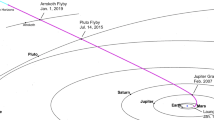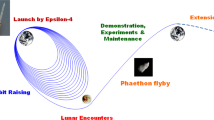Abstract
The dynamics and control of a satellite in proximity to the asteroid Apophis across its Earth close approach in 2029 is evaluated and investigated. First, the feasibility of carrying out close proximity operations about Apophis when in its heliocentric orbit phase is evaluated and shown to be feasible. Then three different types of close proximity motion relative to Apophis are analyzed that will enable a spacecraft to take observations throughout the Earth close approach. These are maintaining a relative orbit that is somewhat distant from Apophis, hovering along the Earth–Apophis line, or maintaining orbit about Apophis through the flyby. Each of these are shown to be feasible, albeit challenging, and some basic aspects of these operations are noted and discussed.









Similar content being viewed by others
References
Ivashkin, V., Krylov, I.: Optimal trajectories for spacecraft with low electric-jet thrust in mission to asteroid Apophis. Dokl. Phys. 57(7), 271–275 (2012)
Ivashkin, V., Lang, A.: Analysis of spacecraft orbital motion around the asteroid Apophis. Dokl. Phys. 61(6), 288–292 (2016)
Plescia, J., Barnouin, O., Richardson, D., Schmerr, N., Lawrence, D., Denevi, B., Ernst, C., Yu, H.: The Asteroid Probe Experiment (APEX) Mission (2017)
Scheeres, D., Benner, L., Ostro, S., Rossi, A., Marzari, F., Washabaugh, P.: Abrupt alteration of Asteroid 2004 MN4’s spin state during its 2029 Earth flyby. Icarus 178(1), 281–283 (2005)
Yu, Y., Richardson, D.C., Michel, P., Schwartz, S.R., Ballouz, R.-L.: Numerical predictions of surface effects during the 2029 close approach of asteroid 99942 Apophis. Icarus 242(2014), 82–96 (2029)
DeMartini, J.V., Richardson, D.C., Barnouin, O.S., Schmerr, N.C., Plescia, J.B., Scheirich, P., Pravec, P.: Using a discrete element method to investigate seismic response and spin change of 99942 Apophis during its 2029 tidal encounter with Earth. Icarus 328, 93–103 (2019)
Ivashkin, V., Lang, A.: Analysis of the orbital motion of the asteroid Apophis? Satellite. Cosm. Res. 55(4), 253–262 (2017)
Brozović, M., Benner, L.A., McMichael, J.G., Giorgini, J.D., Pravec, P., Scheirich, P., Magri, C., Busch, M.W., Jao, J.S., Lee, C.G., et al.: Goldstone and Arecibo radar observations of (99942) Apophis in 2012–2013. Icarus 300, 115–128 (2018)
Pravec, P., Scheirich, P., Ďurech, J., Pollock, J., Kušnirák, P., Hornoch, K., Galád, A., Vokrouhlickỳ, D., Harris, A., Jehin, E., et al.: The tumbling spin state of (99942) Apophis. Icarus 233, 48–60 (2014)
Binzel, R.P., Rivkin, A.S., Thomas, C.A., Vernazza, P., Burbine, T.H., DeMeo, F.E., Bus, S.J., Tokunaga, A.T., Birlan, M.: Spectral properties and composition of potentially hazardous Asteroid (99942) Apophis. Icarus 200(2), 480–485 (2009)
Scheeres, D.: Orbital Motion in Strongly Perturbed Environments: Applications to Asteroid, Comet and Planetary Satellite Orbiters. Springer, London (2012)
Scheeres, D.: Orbit mechanics about asteroids and comets. J. Guid. Control Dyn. 35(3), 987–997 (2012)
Broschart, S., Scheeres, D.: Control of hovering spacecraft near small bodies: application to Asteroid 25143 Itokawa. J. Guid. Control Dyn. 28(2), 343–354 (2005)
Broschart, S., Scheeres, D.: Boundedness of spacecraft hovering under dead-band control in time-invariant systems. J. Guid. Control Dyn. 30(2), 601–610 (2007)
Scheeres, D.: Distant proximity orbits about asteroids. J. Deep Space Eng. 6(5), 448–455 (2019)
Hirabayashi, M.: Hayabusa2 Asteroid Sample Return Mission: Technological Innovation and Advances. Elsevier, Amsterdam (2022)
Hu, W., Scheeres, D.: Spacecraft motion about slowly rotating asteroids. J. Guid. Control Dyn. 25(4), 765–775 (2002)
Carter, T.E.: New form for the optimal rendezvous equations near a Keplerian orbit. J. Guid. Control Dyn. 13(1), 183–186 (1990)
Yamanaka, K., Ankersen, F.: New state transition matrix for relative motion on an arbitrary elliptical orbit. J. Guid. Control Dyn. 25(1), 60–66 (2002)
Dang, Z.: Solutions of Tschauner–Hempel equations. J. Guid. Control Dyn. 40(11), 2956–2960 (2017)
Acknowledgements
The author acknowledges the very helpful reviews and comments from two referees. Their inputs definitely improved the paper.
Author information
Authors and Affiliations
Corresponding author
Additional information
Publisher's Note
Springer Nature remains neutral with regard to jurisdictional claims in published maps and institutional affiliations.
Presented as Paper IAA-AAS-SciTech-034 at the 2nd IAA/AAS SciTech Forum, Moscow, Russia, June 2019.
Appendix
Appendix
The following solution has been developed for relative motion about an eccentric orbit [19, 20]. Here we note that these previous solutions can be extended without loss of generality to the hyperbolic case as well. Define a state vector as \({\bar{\Xi }}_{0} = \left[ {X}_{0}, Y_{0}, Z_{0}, X_{0}', Y_{0}', Z_{0}' \right]\). Then the general orbit solution for linearized motion about an eccentric or hyperbolic orbit can be specified as the linear mapping
where \(\Phi \in {\mathbf {R}}^{6\times 6}\) is the state transition matrix for the system. The entries of \(\Phi\) can be written out in detail as
where we inserted zeros in all of the cross coupling terms between the out-of-plane and in-plane terms. The remaining terms are then, taking \(f_{o} = 0\),
where we note the function L is defined as
where t is the time from perihelion. Thus we see that L will linearly increase in time, and could lead to an overall secular drift.
Rights and permissions
Springer Nature or its licensor (e.g. a society or other partner) holds exclusive rights to this article under a publishing agreement with the author(s) or other rightsholder(s); author self-archiving of the accepted manuscript version of this article is solely governed by the terms of such publishing agreement and applicable law.
About this article
Cite this article
Scheeres, D.J. Proximity Operations About Apophis Through Its 2029 Earth Flyby. J Astronaut Sci 69, 1514–1536 (2022). https://doi.org/10.1007/s40295-022-00360-w
Accepted:
Published:
Issue Date:
DOI: https://doi.org/10.1007/s40295-022-00360-w




